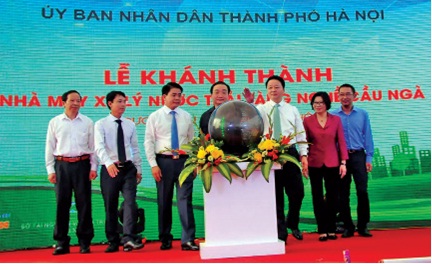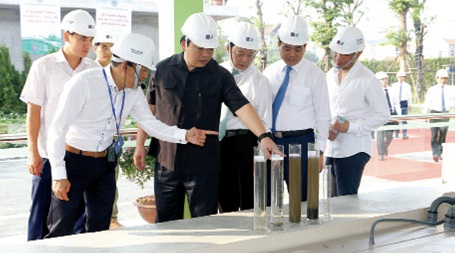

08/09/2017
With the increasing migration as well as rapid development of craft villages, the environment of Hà Nội is facing urgent pressures. Therefore, Hà Nội is developing strategies and planning for environmentally concern craft villages, particularly craft villages in urban areas and crowded residential areas. Accordingly, Hà Nội will invest more than 13,000 billion dong in pollution treatment in 44 craft villages working on agri-food processing; the investment will be implemented from now to 2020. In addition to investments by the State budget, Hà Nội promotes the socialization in environmental protection.

Hà Nội Secretary of Party’s Committee Hoàng Trung Hải, Minister of Natural Resources and Environment Trần Hồng Hà, Chairman of Hà Nội People’s Committee
Nguyễn Đức Chung and Delegates at the launching of the Cầu Ngà Craft Village Wastewater Treatment Factory
The environment state of craft villages in Hà Nội
According to statistics of the Hà Nội Department of Industry and Trade, there are currently more than 1,350 craft villages and villages have different manufacturing types including food processing; animal husbandry, slaughtering; dyeing; construction material production; refuse recycling; craft arts, etc. Craft villages have contributed to reduce poverty, improve livelihoods, and attract labourers and played important roles in the socio-economic development of the locality. However, environmental pollution (air, noise, water, solid waste, etc.) in craft villages is at an alarming rate, causing negative impacts on human health, typically in three craft villages: Dương Liễu, Minh Khai, Cát Quế (Hoài Đức district) which produce noodle products from cassava and arrowroot and discharge, on average, about 13,000 m³ wastewater daily. All wastewater is discharged directly to the drainage and channel system of the commune before flowing to Nhuệ and Đáy rivers. The concentration of organic pollutants in wastewater such as COD, BOD5, NH4+, coliform is many times higher than the limit and the odour is very bad. In some places, cassava and arrowroot resides pile up, disrupting the surrounding beauty and environmental sanitation.
In craft villages, manufacturing activities are at small scale (mostly households) and scattered in residential areas; production activities mix with domestic activities; manufacturing technologies are manual and backward. There are almost no waste, wastewater and air collection and treatment systems. Whereas investments in environmental pollution treatment system in craft villages are limited as households do not have enough budget to invest in the craft village solid waste and wastewater treatment systems.
To overcome and to improve the environmental pollution status in craft villages, Hà Nội has reviewed and developed a list of environmental polluters which are inappropriate with the planning and promulgated the craft village environmental protection action plan in Hà Nội during 2016 - 2020. In addition to prioritising budget for environment, Hà Nội also promotes the socialisation of environmental investments and services supply, promotes research and application of scientific and technical advance in environmental treatment. However, the environment of craft villages is facing many difficulties due to limited resources from the city’s budget. Whereas, the mobilisation of socialisation sources is ineffective as the investments in this area are very high but with low benefits; therefore, enterprises are often not “interested”.
Socialisation model of craft village environmental pollution treatment in Hà Nội
In fact, by now, only one enterprise invests in craft village wastewater treatment which is Phú Điền Investment, Construction and Trade Joint Stock Company (Phú Điền Company). In December 2015, the Company has invested in construction of the Cầu Ngà Craft Village Wastewater Treatment Factory project for wastewater treatment of three craft villages Dương Liễu, Minh Khai, Cát Quế, with 100% fund from the enterprise. This is a pilot project on socialisation mobilisation in craft village environmental pollution treatment according to the orientation of the city.
With close direction of authorities at different levels and guidance of the Hà Nội Department of Natural Resources and Environment, after 10 months of construction, on 8th October 2016, the Cầu Ngà Craft Village Wastewater Treatment Factory has completed with the total investment of 330 billion VND, with an area of 9,397 m². The design capacity of the factory is 20,000 m³/day, using closed biological treatment technology which ensures no secondary odour; the facility is fully automatic and imported from Europe and the wastewater collection system is closed and synchronised. In the test operation on 15th September 2016, the water after treatment of the Factory achieves the regulation of QCTDHN 02:2014/BTNMT of the Ministry of Natural Resources and Environment on industrial wastewater in Hà Nội; the water after treatment can be reused for agriculture irrigation purposes. This is also the first large-scale craft village wastewater treatment system in Hà Nội applying green technologies and energy saving; solar energy batteries are installed on the surface of biological treatment tanks for energy generation of 200 KW/day, providing electricity for the whole factory.
The investment of Phú Điền Company in the Cầu Ngà Craft Village Wastewater Treatment Factory not only reduces environmental pollution and enhances the livelihood quality of local people, but also plays important roles in the socialisation of environmental protection in craft villages. This is a typical example for other enterprises to have the “courage” to invest in and to contribute to the city in addressing environmental pollution in craft villages.

Delegates visit the Wastewater Treatment Factory
However, to promote the socialisation of environmental protection in craft villages in Hà Nội, the city needs to develop mechanisms and incentive policies for socialisation models in environmental treatment in craft villages, creating the necessary legal platform to promote enterprises to invest in environmental protection of craft villages. At the same time, it’s necessary to develop and implement environmental protection agreements, conventions and commitments, mobilize communities to contribute resources in environmental pollution treatment in craft villages; implement specific model on environmental protection socialisation for each craft village type, linked with socio-economic and cultural activities of the craft village, from which to expand the socialisation model in environmental pollution treatment of craft villages across the city, creating the joint strength in environmental protection of the Capital.
P. Linh